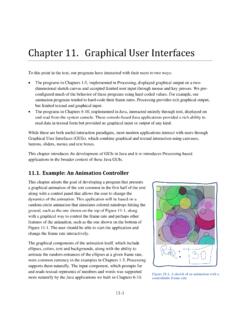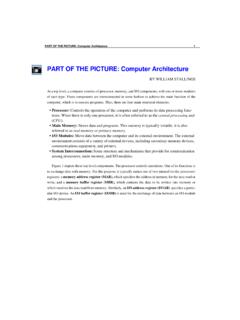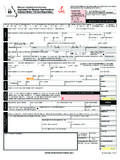Transcription of Chapter 13. Inheritance and Polymorphism - Calvin University
1 13-1 Chapter 13. Inheritance and Polymorphism Objects are often categorized into groups that share similar characteristics. To illustrate: People who work as internists, pediatricians, surgeons, gynecologists, neurologists, general practitioners, and other specialists have something in common: they are all doctors. Vehicles such as bicycles, cars, motorcycles, trains, ships, boats and airplanes are all mobile machines. The elements helium, neon, argon, krypton, xenon, and radon are known as the inert (or noble) gasses because each has the full complement of eight electrons in its outermost atomic shell, and thus does not react readily with other elements. These are just a few of the many situations in which we organize objects into groups because of their common characteristics.
2 When two or more objects have some characteristic in common, those objects are said to be related by virtue of sharing that characteristic. Much of the history of science has involved the classification of objects by identifying their common characteristics. For example, when biologists discover a new species, they study all of its characteristics to determine where it fits into their elaborate classification scheme. One of the aims of object-oriented programming is to simplify the process of building software models of real-world objects. Since real-world objects may be related to one another, an object-oriented language must provide some mechanism for modeling such relationships. In Java, the keyword extends serves this purpose.
3 In this Chapter , we study Java s extends mechanism, and see how it can be used to save coding effort in a carefully designed system. Example: A Figure-Drawing Application Consider the problem of building a drawing application that allows a user to draw different sorts of figures on a drawing canvas. This application might look something like the example shown in Figure 13-1. The application should allow users to choose the figures they d like to draw and the colors they d like to use from a drawing palette of some sort and to use the mouse to specify where the figures go and how large they are. This figure-drawing domain is similar to the domains discussed in the introduction in that it contains a variety of objects such as squares, rectangles, ellipses, lines and squiggles, all of which share the properties common to geometric figures.
4 Such figures have screen locations specifying where they are to be drawn on Figure 13-1. A simple drawing application 13-2 the canvas, fill settings specifying whether they are to be filled with color or merely outlined, and color settings specifying the colors to use. There are also interesting relationships between the different figure types. Squares are also rectangles but not the reverse. Ellipses can be filled, but not lines. A programmer could build different classes to model each figure type, , Rectangle, Ellipse, Line, etc., but that would likely lead to considerable amounts of redundant code. For example, every figure class would have to store an instance variable specifying their color and provide largely identical constructors, accessors and mutators for initializing and managing that variable s value.
5 Redundancy such as this is rarely a good programming practice. This Chapter introduces the techniques offered by object-oriented programming for implementing applications such as this in a more concise and consistent manner. Modeling Objects and Relationships The object-oriented programming (OOP) paradigm is based on three fundamental mechanisms: Encapsulation Inheritance Polymorphism Encapsulation, the focus of Chapter 9, is the language construct that bundles data and methods into a single class specification. Inheritance and Polymorphism are addressed in the following sections. As we ll see, Inheritance is a mechanism for sharing common features amongst classes while Polymorphism is a mechanism for designating unique features for each class.
6 Revisiting the Example Before discussing Inheritance and Polymorphism , this section presents a first iteration of the figure-drawing application introduced in Section , which we will call Simpledraw. It is not difficult to implement a rectangle-drawing version of Simpledraw using mechanisms covered earlier in the text. 13-3 1 2 3 4 5 6 7 8 9 10 11 12 13 14 15 16 17 18 19 20 21 22 23 24 25 26 27 28 29 30 31 32 33 34 35 36 37 38 39 /** * A simple rectangle-drawing class * * @author kvlinden * @version Fall, 2009 */ public class Rectangle { private Point myStart; private int myColor; private int myWidth, myHeight; private boolean myFilled; public Rectangle(Point start, int width, int height, int color, boolean filled) { myStart = start; myColor = color; myWidth = width; myHeight = height; myFilled = filled; } public int getColor() { return myColor; } public void setColor(int color) { myColor = color; } public void render(PApplet p) { (myColor).}}
7 If (myFilled) { (myColor); } else { (); } ( , , myWidth, myHeight); } } The class models a rectangle by encapsulating: instance variables representing the rectangle s starting point (its upper left point), its color, width, height and a boolean indicating whether it is to be filled with color or simply outlined methods specifying how to construct and draw the figure, and an accessor and mutator for the color attribute. As has been our practice since Chapter 11, the render() method receives the drawing context from its calling object, which must be a PApplet, and uses Processing-based drawing methods to render the rectangle on the canvas. As it stands, this class is a perfectly appropriate model of a rectangle, but when we consider adding support for ellipses, lines and other figure types, it s clear that they too will need to represent a color 13-4 attribute and provide support for that attribute in the constructor, draw methods, accessors and mutators.
8 As mentioned in the previous section, we d like to avoid reproducing this amount of redundant code; redundant code is time-consuming to produce and can lead to inconsistencies, say, in the way color is handled for each of the figure types. We would prefer to specify the color attribute in one place and allow all the figure objects to share that attribute. Inheritance Inheritance is a language construct that supports the sharing of features amongst different objects. Consider the domain of vehicles, which includes bicycles, skateboards, cars and jets. On the one hand, vehicles of these types share some common features; they tend to be manufactured by particular companies and identified by a model name or number.
9 For example, the is a particular bicycle model manufactured by Trek Corporation and the Rocket is a particular skateboard model manufactured by Ally Corporation. On the other hand, each of these vehicle types tends to have distinguishing features not shared by other vehicle types. For example, bicycles can be assessed by their number of gears, , 27 for the Trek , while skateboards can be assessed by the length of their board, , the Rocket has a board. Inheritance allows a programmer to separate those attributes and behaviors that are shared between vehicle types and those that are unique to each particular type. The shared features are collected in a single class known as the parent or superclass and the unique features are separated into the child or subclasses.
10 This can be visualized as follows. In class diagrams such as this, subclasses point up to their superclass. The attributes and behaviors implemented in the superclass are inherited by all the subclasses. The attributes and behaviors implemented in one of the subclasses are unique that subclass. In a sense, the features shared by subclass1 and subclass 2, that might otherwise have been implemented separately in each of the subclasses, can be collected and raised up into the single shared superclass. Because Java does not implement multiple Inheritance , subclasses can only have one superclass. Superclasses, on the other hand, can have many subclasses. For example, in the vehicles domain, a programmer might implement the brand and model in a vehicle superclass, the engine size in a car subclass and the number of jet engines in a jet subclass.







